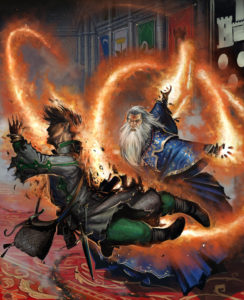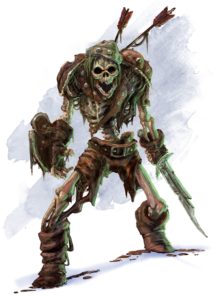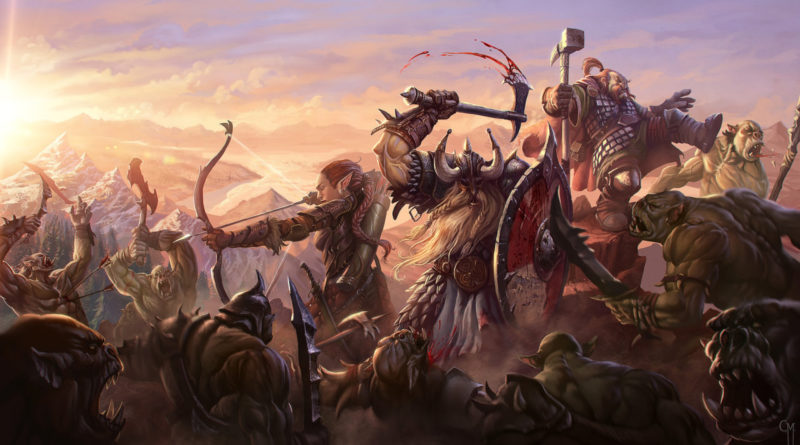Let’s Speed Up Combat in 5e
I’ve always felt like combat could move faster in D&D. I hate to look around the table and see players disinterested because it isn’t their turn. I’d like to make combat much more descriptive, keep the players engaged, and keep things interesting.
Now, I’m not talking about modifying the rules at all here. We’re just looking at how to use the rules to keep everything going.
 To begin with, we need to make initiative very visible. Place clothespins on your DM screen or use some kind of method to show whose turn is coming up. This keeps you from trying to get a player’s attention to let them know its their turn, and even with an engaged player, they’ll know exactly when they’re coming up. Also, when you announce whose turn it is, also announce who’s up next.
To begin with, we need to make initiative very visible. Place clothespins on your DM screen or use some kind of method to show whose turn is coming up. This keeps you from trying to get a player’s attention to let them know its their turn, and even with an engaged player, they’ll know exactly when they’re coming up. Also, when you announce whose turn it is, also announce who’s up next.
Secondly, let’s start revealing the AC of monsters. Certainly, you can keep it hidden, but this leaves players rolling the die, asking if it hits, then you responding, then them rolling the damage die. Instead, players can roll the die, immediately tell if it hit, and begin describing how it hit or missed.
Players should also begin rolling their damage dice with their D20. This way, you can tell both if you hit, and how much damage you do all in one. I’ve done it while playing at the FLGS, and it makes things SO MUCH smoother.
 Also, stop rolling your dice. I’ve spoken about it before here on the site, and I’ve even created a table you can print off yourself. By having a table of die rolls already in front of you, you can just mark them off the sheet as you get to them. As the DM, you IMMEDIATELY know if your monsters hit (making sure to have all your players’ ACs in front of you), and can begin describing the damage.
Also, stop rolling your dice. I’ve spoken about it before here on the site, and I’ve even created a table you can print off yourself. By having a table of die rolls already in front of you, you can just mark them off the sheet as you get to them. As the DM, you IMMEDIATELY know if your monsters hit (making sure to have all your players’ ACs in front of you), and can begin describing the damage.
The players need to know what they’re doing. If they’re going to be casting a spell that requires a save, they should know what the save DC is and then roll the damage while the DM is rolling the save. By prepping players by telling them who’s on deck, they will be looking up this information.
I never roll monster damage. I always use the average, and then bump that number up or down by one or two depending on my whims or based on how much the attack succeeded by. Again, it keeps things moving. Any spells performed that actually need a roll are either averaged, or I have the players roll the damage themselves.
Now, with all this time you’ve taken to make combat quicker, you can focus on the important things: Making combat more interesting. You now don’t feel like you need to rush to the next player because each player turn takes multiple minutes. Let’s look at how this would play out at the table:
 DM: The skeletons shamble into the room. The necromancer stands behind them, guiding them forward. Roll initiative!
DM: The skeletons shamble into the room. The necromancer stands behind them, guiding them forward. Roll initiative!
After initiative is rolled… the initiative tracker that’s visible to everyone lets everyone see who’s up in what order.
DM: The Skeletons’ AC is 13, and the Necromancer’s AC is 12. Brian, you’re up, Samaira, you’re on deck.
BRIAN: (Rolls their D20 and damage die simultaneously) I advance toward the first skeleton, swinging my blade up into its rib-cage, dealing 8 damage.
DM: (Marks the damage) Samaira, you’re up, followed by the Skeletons, then by Dave.
SAMAIRA: I duck behind these barrels and hurl acid from my hands, hitting these two skeletons here. Spell save is 14.
DM: (The DM rolls the save at the same time the player is rolling for damage) They fail…
SAMAIRA: So they each take 4 points of damage as the acid eats through their armor and bones.
DM: (He quickly glances at the roll chart as his turn kicks off) It’s the skeleton’s turns. Two move toward Brian, swinging their rusted swords. One slashes at him, lodging his sword in Brian’s shield, causing no damage, while the other gets in under the shield when Brian is distracted by the flanking skeleton. His sword slashes you across the ribs causing 4 damage. Dave, you’re up, followed by Nick.
–
And that’s how it would go. There’s more time to describe things without the need for a constant out-of-character back and forth between the players and DM. While I’m just a player at the moment, when I get back to DMing I’ll be talking to my players to make things run smoother.


We tested this out this session! It worked so well. My players went through the a challenging encounter in Dragon of Icespire Peak in under 8 minutes. They normally take about 30 to 45 minutes.